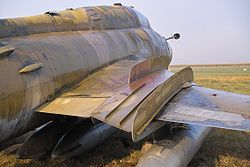
Wing fence
Encyclopedia

Aerodynamics
Aerodynamics is a branch of dynamics concerned with studying the motion of air, particularly when it interacts with a moving object. Aerodynamics is a subfield of fluid dynamics and gas dynamics, with much theory shared between them. Aerodynamics is often used synonymously with gas dynamics, with...
devices attached to aircraft wing
Wing
A wing is an appendage with a surface that produces lift for flight or propulsion through the atmosphere, or through another gaseous or liquid fluid...
s. Not to be confused with wingtip fences, wing fences are flat plates fixed to the upper surfaces (and often wrapping around the leading edge) parallel to the airflow. They are often seen on swept-wing aircraft. They obstruct span-wise airflow along the wing, and prevent the entire wing from stalling
Stall (flight)
In fluid dynamics, a stall is a reduction in the lift coefficient generated by a foil as angle of attack increases. This occurs when the critical angle of attack of the foil is exceeded...
at once.
As a swept-wing aircraft slows toward the stall speed of the wing, the angle of the leading edge forces some of the airflow sidewise, toward the wing tip. This process is progressive, airflow near the middle of the wing is affected not only by the leading edge angle, but also the spanwise airflow from the wing root. At the wing tip the airflow can end up being almost all spanwise, as opposed to front-to-back over the wing, meaning that the effective airspeed drops well below the stall. Because the geometry of swept wings typically places the wingtips of an aircraft aft of its center of gravity
Center of gravity
In physics, a center of gravity of a material body is a point that may be used for a summary description of gravitational interactions. In a uniform gravitational field, the center of mass serves as the center of gravity...
, lift generated at the wingtips tends to create a nose-down pitching moment
Moment (mathematics)
In mathematics, a moment is, loosely speaking, a quantitative measure of the shape of a set of points. The "second moment", for example, is widely used and measures the "width" of a set of points in one dimension or in higher dimensions measures the shape of a cloud of points as it could be fit by...
. When the wingtips stall, both the lift and the associated nose-down pitching moment rapidly diminish. The loss of the nose-down pitching moment leaves the previously balanced aircraft with a net nose-up pitching moment. This forces the nose of the aircraft up, increasing the angle of attack
Angle of attack
Angle of attack is a term used in fluid dynamics to describe the angle between a reference line on a lifting body and the vector representing the relative motion between the lifting body and the fluid through which it is moving...
and leading to stall over a greater portion of the wing. The result is a rapid and powerful pitch-up
Pitch-up
In aerodynamics, pitch-up is a severe form of stall in an aircraft. It is directly related to inherent properties of all swept wings.-History:Pitch-up problems were first noticed on high-speed test aircraft with swept wings...
followed by a complete stall, a difficult situation for a pilot to recover from. The "Sabre dance" (which caused many F-100 Super Sabre
F-100 Super Sabre
The North American F-100 Super Sabre was a supersonic jet fighter aircraft that served with the United States Air Force from 1954 to 1971 and with the Air National Guard until 1979. The first of the Century Series collection of USAF jet fighters, it was the first USAF fighter capable of...
s to crash) is a notable example of this behavior.

Angle of attack
Angle of attack is a term used in fluid dynamics to describe the angle between a reference line on a lifting body and the vector representing the relative motion between the lifting body and the fluid through which it is moving...
response of the wing and moving the stall point to a lower speed.
Wolfgang Liebe, who is generally credited with inventing wing fences, filed a patent for it in 1938
1938 in aviation
This is a list of aviation-related events from 1938:- Events :* Imperial Airways inaugurates scheduled service from London to Montreal. Pan American World Airways is banned from British airports out of fears that more advanced U.S...
while working on the Messerschmitt Me.109B
Messerschmitt Bf 109
The Messerschmitt Bf 109, often called Me 109, was a German World War II fighter aircraft designed by Willy Messerschmitt and Robert Lusser during the early to mid 1930s...
. After World War II
World War II
World War II, or the Second World War , was a global conflict lasting from 1939 to 1945, involving most of the world's nations—including all of the great powers—eventually forming two opposing military alliances: the Allies and the Axis...
, Soviet military aircraft designers
OKB
OKB is a transliteration of the Russian acronym for "Опытное конструкторское бюро" - Opytnoe Konstructorskoe Byuro, meaning Experimental Design Bureau...
became known for their habit of using wing fences, using them on aircraft as varied as Mikoyan MiG-15s and Tupolev Tu-22M
Tupolev Tu-22M
The Tupolev Tu-22M is a supersonic, swing-wing, long-range strategic and maritime strike bomber developed by the Soviet Union. Significant numbers remain in service with the Russian Air Force....
s.

